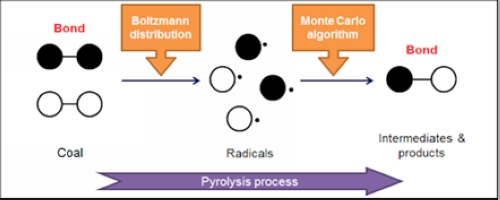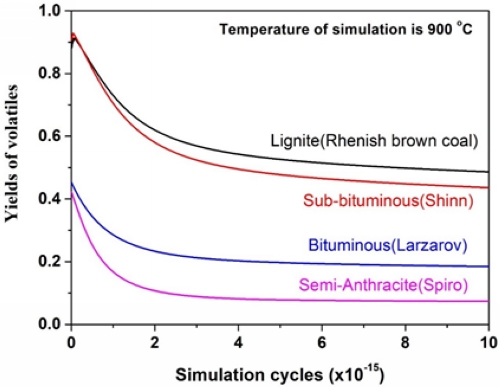The pyrolysis of coal is the common process and foundation of all thermochemical conversion processes of coal. Research on pyrolysis processes has also been a hot topic in the field of coal science research. In addition to experimental research, the study of coal pyrolysis process is also an important research method. By comparing the similarities and differences between the experimental results and the simulation results under the same conditions, the correctness of the assumptions used to build the model can be judged, and some reaction process information that cannot be observed through experiments can be obtained. Model studies have been widely and successfully used in the catalytic and material field calculations. However, for coal, from the microscopic point of view, the huge number of atoms contained in its unit structure leads to a huge amount of calculations, and quantum chemical calculation methods cannot be used. Therefore, the existing models for coal pyrolysis reactions (such as FG-DVC model and CPD model) are still generally macroscopic models. Some empirical parameters are introduced into the hypothetical reaction network. After the parameters are obtained through experiments, the model can be used for prediction. Combining the advantages of microscopic research and macroscopic research, the researchers of the Energy and Power Research Center of the Institute of Engineering Thermophysics of the Chinese Academy of Sciences conducted a mesoscopic perspective on the pyrolysis process of coal. The Boltzmann-Monte Carlo method and the percolation equation were used together to establish the Boltzamann-Monte Carlo-method for the coal pyrolysis process through the assumption that the covalent bond "break-generation" mechanism and the covalent bond inversion product infiltration theory are used in coal pyrolysis. Percolation model. The model can be used to quantitatively simulate the bond structure change and product generation trend of the coal pyrolysis process without including empirical parameters. It can also be used for the volatile yield of different coals and gas production when an empirical parameter is introduced. Quantitative/semi-quantitative predictions of rate, light oil, and tar yield. The relevant research results were published on Fuel and Fuel Processing Technology. The study was funded by the National Natural Science Foundation and the National Key Research and Development Program. Mini Multiuse Shovel,Garden Use Mini Shovel,Ourdoor Mini Shovel,Mini Multi Use Shovel Easy-Go Outdoor Co.,Ltd. , https://www.yjeasy-go.com
Figure 1. The "break-generation" mechanism of coal pyrolysis 
Figure 2. Prediction of coal covalent bond changes by BMP model 
Figure 3. Prediction of volatile yields of different coals by BMP model